Abstract
Smithsonite, dolomite, and calcite are carbonate minerals. The crystal structures and spatial distribution characteristics of their common surface metal sites are similar, leading to difficulty in the flotation separation of smithsonite from these carbonate gangues. In this paper, the floatability of smithsonite, dolomite, and calcite in sodium oleate, salicylhydroxamic acid, and their combined-collector system were systematically studied through single-mineral flotation tests, respectively. The results showed that it was difficult to obtain a noticeable recovery difference between smithsonite–calcite and smithsonite–dolomite in a single-collector system of sodium oleate and salicylhydroxamic acid, both at the same time. In the combined-collector system of salicylhydroxamic acid and sodium oleate with total dosage of 6 × 10−4 mol/L, molar ratio of 3:1, and pH of 8.0, the recovery difference of smithsonite–calcite and smithsonite–dolomite could reach the highest values of 38.46% and 37.98%, respectively, while obtaining the highest smithsonite recovery of 88.19%. The adsorption mechanism of the combined collectors was investigated via Fourier transform infrared spectroscopy, X-ray photoelectron spectroscopy, a collector adsorption test, and zeta potential measurements, respectively.
1. Introduction
Zinc is second only to iron, aluminum, and copper in its global annual metal consumption [1]. Most zinc resources exist in the form of zinc sulfide minerals [2,3]. Zinc oxide minerals are produced by the long-term weathering of zinc sulfide minerals and are generally distributed in the oxidized part of the surface of zinc deposits [4,5,6]. The most common zinc oxide minerals are smithsonite and hemimorphite [7,8,9].
With the massive development of easy-to-select zinc sulfide ore resources, the development and utilization of refractory oxide ore resources represented by smithsonite (ZnCO3) have attracted more and more attention [10,11]. Calcite (CaCO3), dolomite (CaMgCO3), and quartz (SiO2) are the main gangue minerals for smithsonite [12,13,14,15]. Due to the high specific gravity of smithsonite, gravity separation techniques like dense medium separation (DMS) can be used for separating smithsonite from dolomite and silicates gangue, and shaking tables can be used for separating smithsonite from calcite and quartz gangue [16,17,18]. And flotation is also an effective way to separate smithsonite from its main gangue minerals.
The chemical properties of smithsonite are similar to most carbonate minerals like dolomite (CaMgCO3) and calcite (CaCO3) [19]. The crystal structures and the spatial distribution characteristics of the common surface metal sites of the three are similar [20,21]. The difference in their natural floatability is small, and flotation separation is difficult [22], so it is of great scientific and practical importance to study the flotation behavior and theory of smithsonite and its carbonate gangue minerals and guide industrial practice to improve the recovery level of zinc oxide resources.
Sodium oleate and oleic acid are widely used as collectors in the flotation of oxidized ores [23,24]. But these collectors exhibit low selectivity in the mineral systems of smithsonite–dolomite or smithsonite–calcite without adding a depressant [25,26]. Hydroxamic acids have been widely used as chelating-type collectors in recent years, mainly due to their selective formation of complexes with metal ions [27,28]. Among them, benzohydroxamic acid and salicylhydroxamic acid have been explored as collectors in the flotation of smithsonite [29]. But the application of a single collector often has its limitations, such as low selectivity and use of large amounts, and cannot achieve satisfactory results in the flotation of refractory minerals [30]. The flotation of carbonate minerals often requires the combined use of collectors to exert the synergistic effect between the reagents and improve the flotation efficiency [31]. For example, Wang et al. [32] prepared a novel mixed collector by mixing benzohydroxamic acid and sodium oleate applied to the flotation separation of smithsonite from dolomite, which obtained recoveries of approximately 90% and 5% for smithsonite and dolomite, respectively. And other researchers [33] found that the enhancement of smithsonite recovery by potassium amyl xanthate/dodecylamine-hydrochloride combined collectors was more significant than that in benzohydroxamic acid/dodecylamine-hydrochloride, which could be attributed to the difference in the steric effect of the absorbed head group. Recently, the effect of collectors on the selective flotation of smithsonite–calcite, smithsonite–dolomite, and smithsonite–calcite–quartz have been widely investigated [34,35]. But few reports focus on the effect of combined collectors on the selective flotation of smithsonite–calcite–dolomite systems.
Thus, in this paper, the floatability of smithsonite, dolomite, and calcite in sodium oleate, salicylhydroxamic acid, and their combined-collector system was systematically studied through a single-mineral flotation test, Fourier transform infrared (FTIR) spectroscopy, X-ray photoelectron spectroscopy (XPS), a collector adsorption test, and kinetic potential measurement, respectively. Our work has shown that in the single-collector system of sodium oleate and salicylhydroxamic acid, it is difficult to take into account the differences in flotation recovery of smithsonite–calcite and smithsonite–dolomite. The combination of salicylhydroxamic acid and sodium oleate has a good synergistic effect. While ensuring a high recovery rate of smithsonite, it increases the difference in the flotation recovery rate between smithsonite and the other two carbonate minerals.
2. Experimental
2.1. Minerals and Reagents
Pure mineral samples of calcite, dolomite, and smithsonite were collected from Liaoning Province, China. The preparation methods of pure minerals calcite, dolomite, and smithsonite used in this test are as follows: the minerals were firstly manually selected, crushed, ball-milled, and sieved. The −105 μm products were washed with deionized water and dried as test samples. The main chemical composition analysis of the calcite, dolomite, and smithsonite samples is shown in Table 1. The comprehensive analysis of the test results shows that the purity of all prepared test samples is higher than 95%.

Table 1.
Chemical composition of prepared pure minerals.
X-ray diffraction (XRD, Rigaku Industrial Co., Ltd., The Woodlands, TX, USA, D/MAX-RB) was used to analyze the crystalline structure of the minerals, and the related patterns of calcite, dolomite, and smithsonite are shown in Figure 1. It can be seen from Figure 1 that the diffraction peaks of all samples correspond to the peaks of pure minerals, which further indicates that the samples have high purity.
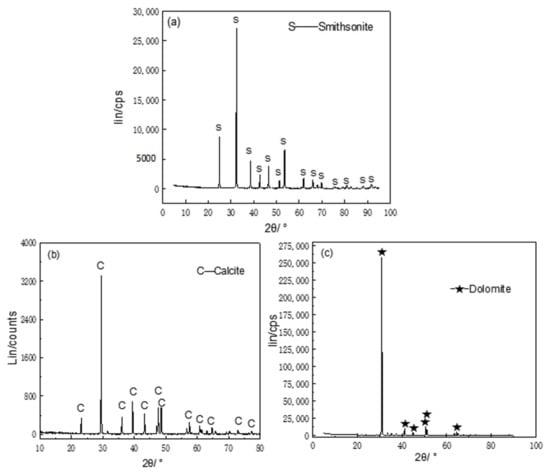
Figure 1.
XRD patterns of (a) smithsonite, (b) calcite, and (c) dolomite.
For the reagents used in the flotation test, sodium oleate (C18H33NaO2, chemically pure) and salicylhydroxamic acid (C7H7NO3, analysis pure) were used as the collectors. Hydrochloric acid (HCl, analysis pure) and sodium hydroxide (NaOH, analysis pure) were used as pH regulators. All chemicals used were purchased from Sinopharm Chemical Reagent Co., Ltd., Shanghai, China. The reagents used in the test were prepared with deionized water, and the pH of the deionized water used in the test was around 7.
2.2. Flotation Tests
The flotation test was carried out in an XFG-type flotation machine with a 40 mL plexiglass cell. The mineral samples were firstly cleaned with an ultrasonic cleaner (KQ2200DE, Kunshan Ultrasonic Instrument Co., Ltd., Kunshan, China) for 2 min. All minerals were flotated separately in the experiments. The mineral pulp was prepared by adding 2.0 g of the mineral sample and 25 mL of deionized water to the cell. HCl and NaOH can quickly adjust pH levels in very small amounts. In addition, the ions generated by these two regulators have little impact on the flotation system. So the pH was adjusted with HCl or NaOH, and stirred for 2 min. And the collector was added sequentially with a mixing time of 2 min. After that, the flotation was performed for 4 min. It should be noted that pine oil was used in very small amounts as a frother for flotation carried out in acidic conditions after adding the collector. The float and sink fractions were dried and weighed, respectively, and the recovery was calculated. The rotating speed of the flotation machine was 1900 r/min. The single-mineral flotation test process is shown in Figure 2.
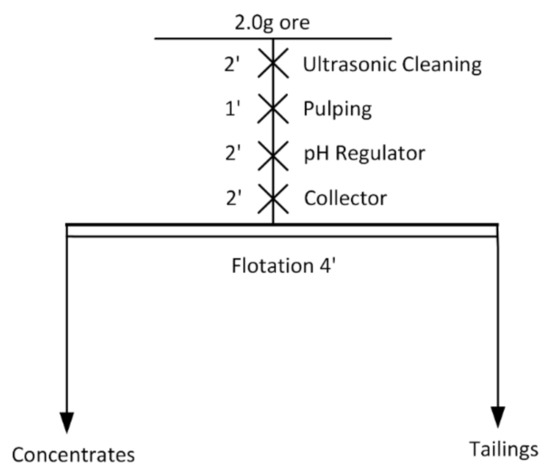
Figure 2.
The single-mineral flotation test process.
2.3. Zeta Potential Measurement
Zeta potential measurements were carried out to determine the zeta potential of minerals under different pH conditions and the action of different reagents. Single minerals were ground to a particle size of less than 5 μm using an agate mortar and pestle; the surface of the minerals was cleaned with an ultrasonic cleaner; and 50 mg of the mineral samples were weighed and dispersed into 50 mL of deionized water each time. The pH was adjusted with a NaOH or HCl solution, and the samples were stirred for 10 min with a thermostatic magnetic stirrer; then, potentiometric measurements were made using a Malvern Nano-ZS90 Zeta Potential Analyzer (Malvern Panalytical, Westborough, MA, USA). Each sample was measured 3 times to obtain the average value.
2.4. Collector Adsorption Test
The absorbance of different concentrations of the prepared collector solution was measured with a Lambda 900 UV-Vis spectrophotometer (PerkinElmer, Waltham, MA, USA), and the standard curve of the collector solution was plotted with the absorbance of the solution as the horizontal coordinate and the concentration of the corresponding solution as the vertical coordinate. In the subsequent operation, the slurry was centrifuged under different reagent regimes for ultraviolet spectrometry; compared with the standard curve of the collector solution to obtain the centrifuged slurry reagent concentration; and finally converted to obtain the adsorption amount of the collector on the surface of the minerals.
2.5. FTIR Measurement
The infrared spectra of mineral surfaces in the presence of different reagents were experimentally determined. The chemical bond and functional group compositions of the prepared samples were analyzed on an FTIR spectrometer, the NICOLET 380 (Thermo Scientific, Waltham, MA, USA), using the potassium bromide compression method, and the differences in the absorption peaks under the different reagent regimes were compared to determine the mechanism and effect of the different reagents on the mineral surfaces. All FTIR spectra were tested in the wave number range of 400–4000 cm−1.
2.6. XPS Measurement
The XPS spectra of mineral surfaces in the presence of different reagents were determined experimentally. The chemical composition and elemental valence states of the samples were detected using an X-ray photoelectron spectrometer, the EscaLab 250Xi (Thermo Fisher Scientific, Waltham, MA, USA), with a scanning step of 0.06 eV. The differences in the changes of the target elements in the samples were analyzed and compared to determine the mechanisms and effects of the different reagent regimes on the mineral surfaces. The binding energy of C1s at 284.8 eV was used for energy calibration.
3. Results and Discussion
3.1. Floatability in Sodium Oleate
Using sodium oleate as a collector, the effects of different concentrations of sodium oleate on the flotation recovery of pure minerals such as calcite, dolomite, and smithsonite were investigated under natural pH conditions (around 7.7 without a pH regulator). The test results are shown in Figure 3.
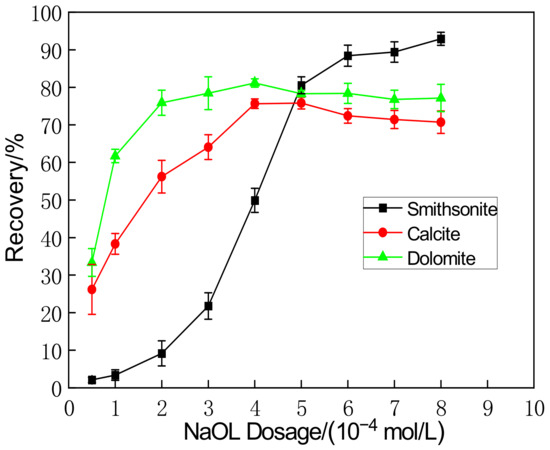
Figure 3.
The effect of the concentration of sodium oleate on the flotation separation among smithsonite, calcite, and dolomite.
The test results show that the recoveries of the three minerals increase rapidly with the increasing concentration of sodium oleate when the concentration range is below 4 × 10−4 mol/L. When the concentration of sodium oleate is greater than 6 × 10−4 mol/L, the recoveries of the three minerals tend to be flat. On the other hand, the recoveries of both calcite and dolomite are larger than that of smithsonite when the concentration of sodium oleate is less than 5 × 10−4 mol/L, indicating that the floatability of these two carbonate gangue minerals is better than that of smithsonite under natural pH conditions, unless the dosage is increased to a large extent. But the recovery difference between smithsonite and the gangue minerals is still not large. Therefore, smithsonite, calcite, and dolomite cannot be effectively separated under natural pH conditions.
When the concentration of sodium oleate is greater than 6 × 10−4 mol/L, the recovery difference among the three minerals exhibited small variation, as shown in Figure 3. Therefore, from the perspective of collector dosage control, the collector concentration of 6 × 10−4 mol/L was selected for pH study. To further effectively separate smithsonite and carbonate gangue with a sodium oleate concentration of 6 × 10−4 mol/L, flotation tests were carried out on smithsonite, calcite, and dolomite under different pH conditions, and the test results are shown in Figure 4.
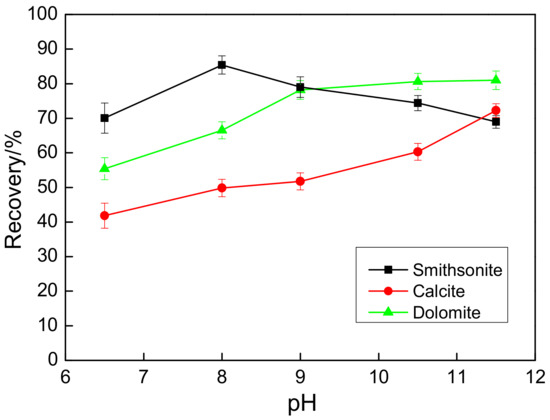
Figure 4.
The influence of pH on the flotation separation among smithsonite, calcite, and dolomite with 6 × 10−4 mol/L sodium oleate.
The test shows that the recovery of calcite and dolomite increases with the increase in the pH value, but the recovery rate of smithsonite increases first and then decreases slowly with the increase in the pH value. The flotation recovery of smithsonite and calcite reached the maximum difference of 36.33% under weakly alkaline conditions of pH = 8.0, and the recovery rates of smithsonite and calcite were 85.90% and 49.57%, respectively. At pH = 8.0, the difference in flotation recovery of smithsonite and dolomite also reaches the maximum, but this is only about 20%. Therefore, the difference in the recovery of smithsonite, calcite, and dolomite should be further expanded, and at the same time, the recovery of calcite and dolomite should be reduced to a certain value to achieve effective flotation separation and obtain a high-purity smithsonite concentrate. On the other hand, it can be seen that sodium oleate has a certain ability to collect the three minerals under different pH values. Only adjusting the pH value cannot achieve the effective separation of smithsonite and calcite flotation by using sodium oleate as a collector.
3.2. Floatability in Salicylhydroxamic Acid
With salicylhydroxamic acid as a collector, the effects of different concentrations of the collector on the flotation recovery of pure minerals such as calcite, dolomite, and smithsonite were investigated under natural pH conditions (around 8.2). The test results are shown in Figure 5. The test results show that in the salicylhydroxamic acid system, the recovery of smithsonite rises rapidly from 41.35% to 86.45% in the range of salicylhydroxamic acid concentration from 2 × 10−4 to 10 × 10−4 mol/L. The recovery of calcite rose slowly from 27.89% to 53.67%, and then the recovery rates of the two minerals tended to be flat. Dolomite shows a good increasing trend throughout the concentration interval, and the recovery could reach 75.68% at a salicylhydroxamic acid concentration of 10 × 10−3 mol/L. Thus, the recovery of smithsonite is higher than that of calcite and dolomite under a salicylhydroxamic acid system.
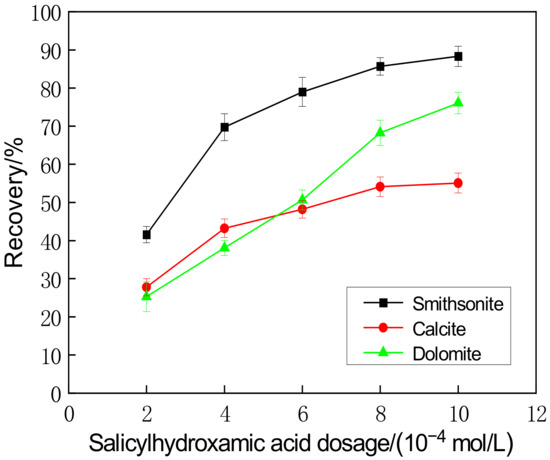
Figure 5.
The effect of the concentration of salicylhydroxamic acid on the flotation separation among smithsonite, calcite, and dolomite.
The recovery difference value of smithsonite with calcite and dolomite can reach 26.62% and 30.71%, respectively, when the concentration of salicylhydroxamic acid is 4 × 10−4 mol/L, but the recovery of smithsonite is as low as 69.29%. When the concentration of salicylhydroxamic acid is 6 × 10−4 mol/L, the recovery difference value of smithsonite with calcite and dolomite reaches 31.37% and 29.49%, and the recovery of smithsonite can reach a higher 79.78% at this time.
To investigate the effect of pH value on the flotation separation of smithsonite and carbonate gangue with salicylhydroxamic acid, a single-mineral flotation test of smithsonite, calcite, and dolomite was carried out with a salicylhydroxamic acid concentration of 6 × 10−4 mol/L. The test results are shown in Figure 6. It can be seen that the recovery of smithsonite reaches a peak of 88.59% at a pH value of 8.0, and then gradually decreases with the increase in the pH value. The recovery of dolomite decreases slowly with the increase in the pH value. With the pH value increasing to 8.0–9.0, the recovery rate of calcite reaches peak values of 55.78%–57.38% and then drops rapidly to a low point. On the other hand, it can be seen that when the pH = 8.0, the flotation recovery difference values of smithsonite–calcite and smithsonite–dolomite can all reach high values, which are 32.81% and 31.21%, respectively, and the high recovery of smithsonite can be obtained.
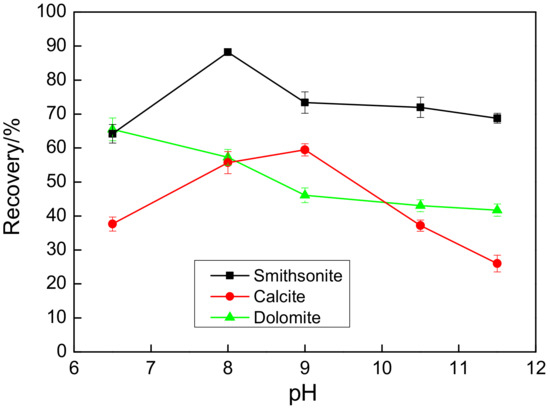
Figure 6.
The influence of pH on the flotation separation among smithsonite, calcite, and dolomite with 6 × 10−4 mol/L salicylhydroxamic acid.
3.3. Floatability in Salicylhydroxamic Acid and Sodium Oleate
The effect of the combination of salicylhydroxamic acid and sodium oleate on the flotation of smithsonite, calcite, and dolomite was studied. When the total dosage of salicylhydroxamic acid and sodium oleate is 8 × 10−4 mol/L, different proportions of salicylhydroxamic acid and sodium oleate affect the flotation separation of smithsonite from calcite and dolomite, which was investigated at pH = 8.0; the test results are shown in Figure 7. It can be seen from Figure 7 that, under different proportions of salicylhydroxamic acid/sodium oleate combined collectors, the recovery of smithsonite is higher than that of calcite and dolomite. The combination of different proportions of salicylhydroxamic acid and sodium oleate has little effect on the recovery of smithsonite but has a large influence on calcite and dolomite.
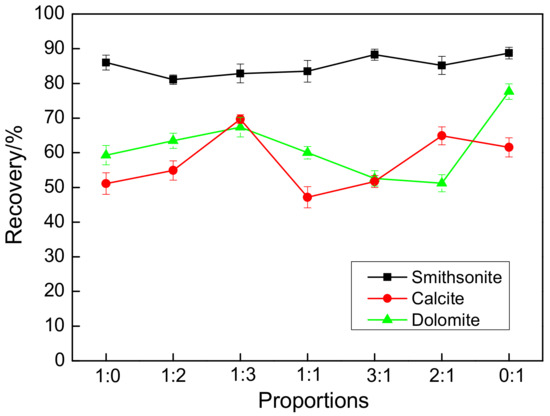
Figure 7.
Effects of salicylhydroxamic acid/sodium oleate molar ratio on the flotation separation among smithsonite, calcite, and dolomite.
Table 2 shows the effect of the molar ratio of salicylhydroxamic acid/sodium oleate on the recovery of smithsonite, calcite, and dolomite when the total fixed dosage is 8 × 10−4 mol/L at pH = 8.0. It can be seen from Table 2 that when the molar ratio of salicylhydroxamic acid/sodium oleate is 3:1, the mineral flotation comprehensive difference rates of smithsonite–calcite and smithsonite–dolomite are the best, which can, respectively, reach 37.18% and 35.90%. The results show that without adding a depressant, a certain flotation separation effect of smithsonite, calcite, and dolomite can also be achieved by adding combined collectors.

Table 2.
Effects of salicylhydroxamic acid/sodium oleate molar ratio on the recovery difference of smithsonite and carbonate gangue mineral.
When the molar ratio of salicylhydroxamic acid/sodium oleate is selected as 3:1, the influence of the dosage of the combined collector on the flotation separation of smithsonite, calcite, and dolomite at pH = 8.0 is investigated, and the results are shown in Figure 8. It can be seen from Figure 8 that under the combination of different dosages of salicylhydroxamic acid and sodium oleate, the recovery of smithsonite is higher than that of calcite and dolomite. When the combined dosage exceeds 4 × 10−4 mol/L, the recovery of smithsonite tends to be flat. The recovery rate of calcite tends to be flat when the combined dosage exceeds 10 × 10−4 mol/L. The recovery rate of dolomite increases slowly with the increase in the combined-collector dosage.
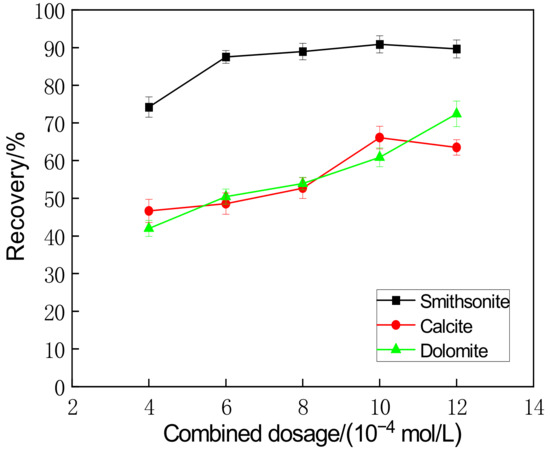
Figure 8.
Effects of salicylhydroxamic acid/sodium oleate dosage on the flotation separation among smithsonite, calcite, and dolomite.
Table 3 shows the effect of the total dosage of combined collectors on the difference in the recovery of smithsonite, calcite, and dolomite when the molar ratio of salicylhydroxamic acid/sodium oleate is fixed at 3:1 at pH = 8.0. It can be seen from Table 3 that, when the total dosage of salicylhydroxamic acid + sodium oleate is 6 × 10−4 mol/L and 8 × 10−4 mol/L, the comprehensive recovery difference rates of smithsonite–calcite and smithsonite–dolomite can reach a higher value, which can reach 39.13% and 37.34%, and 36.78% and 35.23%, respectively. The results show that the best flotation separation effect can be achieved when the combined-collector dosage is reduced to 6 × 10−4 mol/L.

Table 3.
Effects of salicylhydroxamic acid + sodium oleate dosage on the recovery difference of smithsonite and carbonate gangue mineral.
When the total amount of salicylhydroxamic acid + sodium oleate was fixed at 6 × 10−4 mol/L and the molar ratio was 3:1, the effects of different pH values on the flotation separation of smithsonite, calcite, and dolomite were investigated. The results are shown in Figure 9. It can be seen from Figure 9 that the recovery of smithsonite can reach the highest value of 88.19% when the pH value is 8.0, and the second value is 80.29% when the pH value is 9.0. When the recovery of dolomite and calcite is less than 9.0, the pH value has little effect on the recovery rate of the two. But the recovery of the three minerals decreases gradually when the pH value is greater than 9.0, which is mainly due to the competitive adsorption of OH− on the mineral surface and the reduction in the concentration of the active component of the collector.
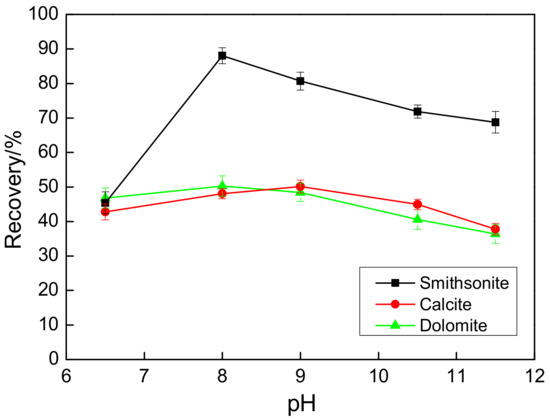
Figure 9.
Effects of pH on the flotation separation among smithsonite, calcite, and dolomite.
Table 4 shows the effect of the pH value on the recovery of smithsonite, calcite, and dolomite when the total dosage of salicylhydroxamic acid + sodium oleate is 6 × 10−4 mol/L and the molar ratio is 3:1. It can be seen from Table 4 that when the pH value is 8.0, while the highest recovery of smithsonite is 88.19%, the comprehensive difference rate of the mineral flotation of smithsonite–calcite and smithsonite–dolomite can reach the highest values of 38.46% and 37.98%, respectively. When the pH value is 9.0, the second-highest recovery of 80.29% can be obtained for smithsonite, while the mineral flotation comprehensive difference rate of smithsonite–calcite and smithsonite–dolomite can also reach about 30%. Therefore, to obtain a better difference in the recovery rates of smithsonite, calcite, and dolomite when using salicylhydroxamic acid + sodium oleate as a combined collector, the condition is that the total dosage is 6 × 10−4 mol/L, with a salicylhydroxamic acid/sodium oleate molar ratio of 3:1 and a pH value of 8.0–9.0.

Table 4.
Effects of pH on the recovery difference of smithsonite and carbonate gangue mineral.
3.4. Adsorption Mechanism of Combined Collectors
It can be known from Section 3.3 that salicylhydroxamic acid and sodium oleate have a good synergistic effect on the separation of smithsonite, calcite, and dolomite when used as combined collectors, so it is important to clarify the adsorption mechanism of combined collectors on the three mineral surfaces. Figure 10 shows the surface potentials of the three minerals at pH 8.0 with different concentrations of combined collectors (salicylhydroxamic acid/sodium oleate molar ratio of 3:1). It can be seen from Figure 10 that the potential of the surface of the three minerals is more negative after the combined collector acts, indicating that the combined collector also makes the surface of the three minerals have a different type of adsorption besides electrostatic adsorption. On the other hand, it can be seen that the surface potentials of smithsonite and carbonate gangue minerals are significantly different when the combined-collector concentration is above 6 × 10−4 mol/L, indicating that the addition of combined collectors has a significant effect on the flotation separation for smithsonite and these two carbonate gangues, which is also consistent with the actual single-mineral flotation results.
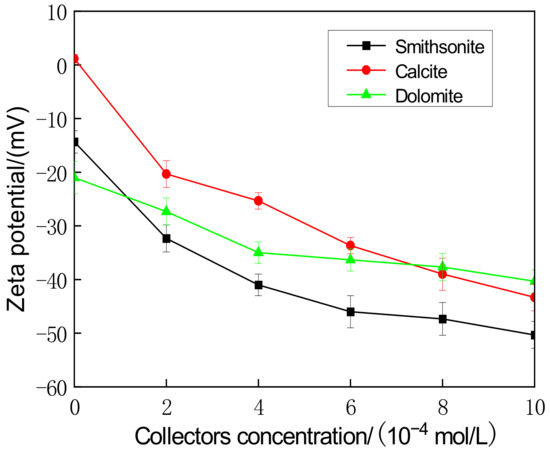
Figure 10.
Surface potentials of three minerals with different combined-collector concentrations at pH 8.0.
Figure 11 shows the adsorption capacity of the three minerals on the combined collectors when the pH value is 8.0 and different concentrations of the combined collector are added (the molar ratio of salicylhydroxamic acid/sodium oleate is 3:1). It can be seen from Figure 11 that, with the increase in the addition of the combined collector, the adsorption dosage on the mineral surface also gradually increases. However, the adsorption of combined collectors on the surface of smithsonite is stronger than that of dolomite and calcite. The higher the concentration added, the more obvious the difference, indicating that the combined collector is helpful for the flotation separation of smithsonite and carbonate gangues.
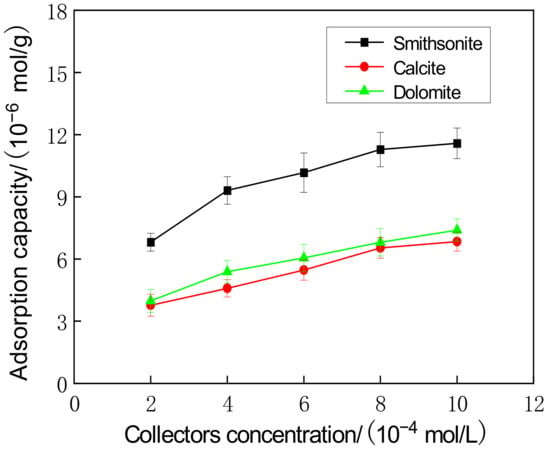
Figure 11.
Collector adsorption of three minerals with different combined-collector concentrations at pH 8.0.
Figure 12a,b show the infrared spectra of smithsonite before and after the adsorption of the combined collectors. In the FTIR measurement, the total amount of salicylhydroxamic acid and sodium oleate was fixed at 6 × 10−4 mol/L, and the molar ratio was 3:1. There are strong absorption peaks around 1420, 868, and 742 cm−1 in the two infrared spectra, which are caused by the anion CO32− in the smithsonite (ZnCO3) [36]. In the spectra of smithsonite treated with combined collectors, a new obvious absorption peak appears at 2922 cm−1, which is the objection of the C−H bonds in both sodium oleate and salicylhydroxamic acid in the combined collectors [37]. This is called the superposition result of the stretching vibration peak, so the intensity of the absorption peak is higher than that of adding a mono-collector, indicating that the combined collector has strong adsorption on the surface of smithsonite. In addition, after the combined-collector treatment, the absorption peak of the original smithsonite at 1420 cm−1 is blue-shifted to 1422 cm−1, which is different from the previous red-shift phenomenon, indicating that the combined collector had stronger chemisorption on the surface of smithsonite. Figure 12c,d show the infrared spectra of calcite before and after treatment with the combined collector. Due to the presence of the anion CO32− in calcite, corresponding absorption peaks appear around 1421, 875, and 712 cm−1 on the two infrared spectra [38]. In addition, through the comparison of other peaks, it can be seen that the infrared spectrum of calcite has no change after the treatment, indicating that the adsorption of combined collectors on the surface of calcite is weak. Figure 12e,f show the infrared spectra of dolomite before and after treatment with the combined collector. It can be seen that the corresponding anion CO32− absorption peaks also appear on the two infrared spectra. In the spectrum of dolomite treated with combined collectors, a new obvious absorption peak appeared at 2923 cm−1, which is the same as smithsonite, and this peak is related to the sodium oleate and salicylhydroxamic acid in the combined collectors. The superposition results of the antisymmetric stretching vibration peaks of the C−H bond are related, indicating that the combined collectors are adsorbed on the dolomite surface. In addition, after the combined-collector treatment, the absorption peak of the original dolomite shows no shift, indicating that the combined collectors had weaker adsorption on the surface of dolomite than smithsonite. Therefore, the combination of collectors can weaken the adsorption on the dolomite surface. In summary, from the results of the infrared spectroscopy test, it can be seen that the order of the adsorption strength of the combined collectors on the surface of the three minerals is smithsonite > dolomite > calcite. The FTIR measurement under 6 × 10−4 mol/L of salicylhydroxamic acid or sodium oleate was also carried out; the results are shown in Figures S1 and S2. As shown in Figure S1, salicylhydroxamic acid exhibits obvious adsorption on the surfaces of smithsonite and dolomite, but the adsorption effect on calcite is weak. The IR spectra of calcite and dolomite did not change after the treatment of sodium oleate, indicating that the adsorption of sodium oleate on the surface of calcite and dolomite is weaker than that of smithsonite, as shown in Figure S2, so it can be inferred that the adsorption difference of the combined collectors on the surface of smithsonite and two gangue minerals will increase after the treatment of combined collectors.
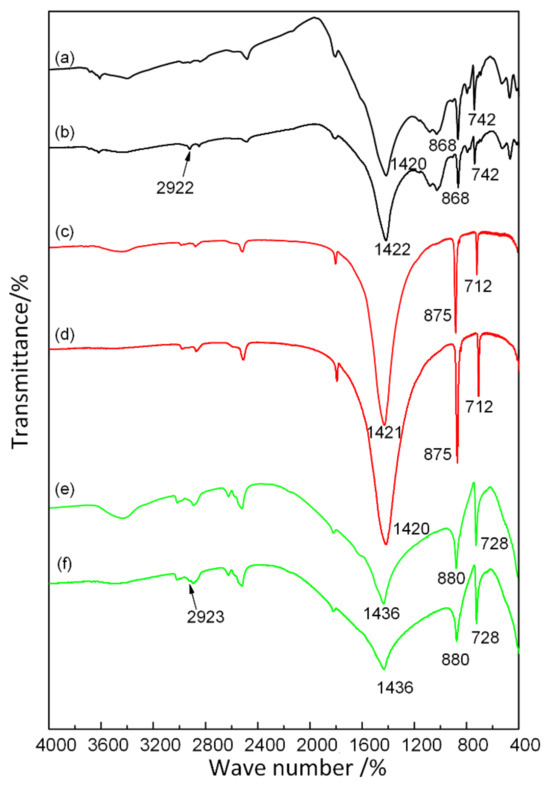
Figure 12.
FTIR spectra of three minerals before and after treatment with the combined collectors. (a) smithsonite before, (b) smithsonite after, (c) calcite before, (d) calcite after, (e) dolomite before, and (f) dolomite after.
Figure 13a,b show the N 1s and C 1s spectra obtained in the XPS detection of the three minerals after treatment with the combined collectors. The difference in the adsorption of salicylhydroxamic acid on the mineral surface will be shown as the difference in the strength of the N element peak in the N 1s spectrum of the XPS test. As shown in Figure 13a, the absorption peak related to the N atom in salicylhydroxamic acid appears at 406 eV of the N 1s spectrum [39]. But by comparing the XPS spectra of the three minerals, there is no obvious difference in the intensity of the N 1s peak relative to the background. In addition, by comparing the three spectra in Figure 13b, it can be seen that there are two absorption peaks on the C 1s spectrum, among which the absorption peak at 284 eV is caused by sodium oleate in the combined collector and organic carbon in salicylhydroxamic acid, while the absorption peak at 289 eV corresponds to CO32− in the three mineral crystals [40,41]. After the treatment of the combined collectors, it can be observed that the 284 eV absorption peaks of C 1s on the surface of the three minerals have changed to varying degrees, among which the 284 eV absorption peak intensity of smithsonite (relative to the baseline) has the largest increase, indicating that the combined collector has the strongest adsorption on the surface of smithsonite. On the other hand, it can also be observed that the 284 eV absorption peak change intensity of C 1s on the dolomite surface after the treatment of the combined collector is higher than calcite. The combined results of N 1s and C 1s show that the order of adsorption strength of combined collectors on the surfaces of the three minerals is smithsonite > dolomite > calcite.
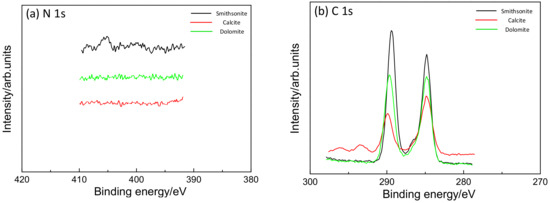
Figure 13.
XPS spectra of three minerals after treatment with the combined collectors. (a) N 1s; (b) C 1s.
4. Conclusions
The recovery difference in the mineral flotation of smithsonite–calcite and smithsonite–dolomite could be enlarged significantly by using combined collectors of salicylhydroxamic acid and sodium oleate. With the total amount of 6 × 10−4 mol/L, a molar ratio of 3:1, and a pH of 8.0, the recovery difference of smithsonite–calcite and smithsonite–dolomite could reach the highest values of 38.46% and 37.98%, respectively. Meanwhile, the highest smithsonite recovery of 88.19% could also be obtained. The adsorption strength of the combined collectors on the surface of the three minerals was in the order of smithsonite > dolomite > calcite, but there was little difference in adsorption strength between dolomite and calcite, which was consistent with the single-mineral flotation results. Our work provides a beneficial approach for the flotation separation of carbonate minerals.
Supplementary Materials
The following supporting information can be downloaded at https://www.mdpi.com/article/10.3390/min13121527/s1: Figure S1: IR spectra of three minerals before and after treatment with salicylhydroxamic acid; Figure S2: IR spectra of three minerals before and after treatment with sodium oleate.
Author Contributions
Conceptualization, X.C. and J.B.; formal analysis, J.B., Z.Z., W.Q. and S.H.; funding acquisition, W.Y. and X.C.; Investigation, X.C. and Y.O.; methodology, J.B. and T.L.; project administration, X.C.; resources, W.Y.; supervision, W.Y.; validation, J.B.; visualization, X.C. and Z.Z. All authors have read and agreed to the published version of the manuscript.
Funding
The project was supported by the National Natural Science Foundation of China (52004069) and the Talent Fund of Fuzhou University (GXRC-20022).
Data Availability Statement
The data presented in this study are available on request from the corresponding author. The data are not publicly available due to privacy and ethical restrictions.
Conflicts of Interest
The authors declare no conflict of interest. J.B. is employee of Zijin Mining Group Co., Ltd. The company had no roles in the design of the study; in the collection, analysis, or interpretation of data; in the writing of the manuscript, or in the decision to publish the articles. The paper reflects the views of the scientists and not the company.
References
- Hernández-Escobar, D.; Champagne, S.; Yilmazer, H.; Dikici, B.; Boehlert, C.J.; Hermawan, H. Current status and perspectives of zinc-based absorbable alloys for biomedical applications. Acta Biomater. 2019, 97, 1–22. [Google Scholar] [CrossRef] [PubMed]
- Wei, J.; Zheng, X.; Liu, J.; Zhang, G.; Zhang, Y.; Wang, C.; Liu, Y. The levels, sources, and spatial distribution of heavy metals in soils from the drinking water sources of Beijing, China. Sustainability 2021, 13, 3719. [Google Scholar] [CrossRef]
- Wang, H.J.; Feng, Y.L.; Li, H.R.; Kang, J.X. Simultaneous extraction of gold and zinc from refractory carbonaceous gold ore by chlorination roasting process. Trans. Nonferrous Met. Soc. China 2020, 30, 1111–1123. [Google Scholar] [CrossRef]
- Li, X.; Wu, L.; Zhou, J.; Luo, Y.; Zhou, T.; Li, Z.; Hu, P.J.; Christie, P. Potential environmental risk of natural particulate cadmium and zinc in sphalerite-and smithsonite-spiked soils. J. Hazard. Mater. 2022, 429, 128313. [Google Scholar] [CrossRef] [PubMed]
- Liu, T.; Zhu, C.; Yang, G.; Zhang, G.; Fan, H.; Zhang, Y.; Wen, H. Primary study of germanium isotope composition in sphalerite from the Fule Pb–Zn deposit, Yunnan province. Ore Geol. Rev. 2020, 120, 103466. [Google Scholar] [CrossRef]
- Zhang, S.; Wen, S.; Xian, Y.; Zhao, L.; Feng, Q.; Bai, S.; Lang, J. Lead ion modification and its enhancement for xanthate adsorption on smithsonite surface. Appl. Surf. Sci. 2019, 498, 143801. [Google Scholar] [CrossRef]
- Sun, H.; Niu, F.; Zhang, J. Investigation on the flotation separation of smithsonite from calcite using calcium lignosulphonate as a depressant. Colloid Surface. A 2021, 630, 127571. [Google Scholar] [CrossRef]
- Li, P.; Zhang, G.; Zhao, W.; Han, G.; Feng, Q. Interaction mechanism of Fe3+ with smithsonite surfaces and its response to flotation performance. Sep. Purif. Technol. 2022, 291, 121001. [Google Scholar] [CrossRef]
- Zhang, S.; Wen, S.; Liang, G.; Xian, Y.; Chen, L. Ammonia pretreatment for enhancement of Pb ions adsorption on smithsonite surface and its flotation performance. Appl. Surf. Sci. 2022, 590, 153069. [Google Scholar] [CrossRef]
- Luo, B.; Liu, Q.; Deng, J.; Yu, L.; Lai, H.; Song, C.; Li, S. Characterization of sulfide film on smithsonite surface during sulfidation processing and its response to flotation performance. Powder Technol. 2019, 351, 144–152. [Google Scholar] [CrossRef]
- Southwood, M.; Cairncross, B.; Rumsey, M.S. Minerals of the Kabwe (“Broken Hill”) mine, central province, Zambia. Rocks Miner. 2019, 94, 114–149. [Google Scholar] [CrossRef]
- Zhu, H.; Qin, W.; Chen, C.; Chai, L.; Li, L.; Liu, S.; Zhang, T. Selective flotation of smithsonite, quartz and calcite using alkyl diamine ether as collector. Trans. Nonferrous Met. Soc. China 2018, 28, 163–168. [Google Scholar] [CrossRef]
- Cairncross, B. Minerals of Berg Aukas, Otavi Mountainland, Namibia. Rocks Miner. 2021, 96, 110–147. [Google Scholar] [CrossRef]
- Boni, M.; Gilg, H.A.; Balassone, G.; Mondillo, N.; Menschik, F.; Rumsey, M.; Struck, U. Stable isotopes of non sulphide Zn–Pb ores in Britain and Ireland: Fluid characteristics and palaeoclimatic variability. J. Geol. Soc. 2019, 176, 1107–1119. [Google Scholar] [CrossRef]
- Shang, Y.; Sun, C. Effect of Gangue Minerals on Pulp Rheology and Flotation Behavior of Smithsonite. Minerals 2023, 13, 66. [Google Scholar] [CrossRef]
- Khalil, A.; Argane, R.; Benzaazoua, M.; Bouzahzah, H.; Taha, Y.; Hakkou, R. Pb–Zn mine tailings reprocessing using centrifugal dense media separation. Miner. Eng. 2018, 131, 28–37. [Google Scholar] [CrossRef]
- Ebtedaei, A.; Farzanegan, A. A Detailed study of Applying Gravity Separation to Lead and Zinc Carbonate Ore for Smithsonite Concentration Using DMC. Miner. Process. Extr. Metall. Rev. 2020, 41, 381–395. [Google Scholar] [CrossRef]
- Farag, M.Z.; Abdel-Khalek, N.A.; Hassan, M.S.; El Aref, M.M.; El Manawi, A.W. Upgrading of Egyptian Nonsulfide Zinc Ore by Gravity Separation Techniques. J. Metall. Eng. 2012, 1, 6–13. [Google Scholar]
- Yang, J.; Huo, X.; Li, Z.; Ma, S. Study on Hydrometallurgical Treatment of Oxide Ores Bearing Zinc. Minerals 2022, 12, 1264. [Google Scholar] [CrossRef]
- Bishop, J.L.; King, S.J.; Lane, M.D.; Brown, A.J.; Lafuente, B.; Hiroi, T.; Roberts, R.; Swayze, G.A.; Lin, J.-F.; Sánchez Román, M. Spectral properties of anhydrous carbonates and nitrates. Earth Space Sci. 2021, 8, e2021EA001844. [Google Scholar] [CrossRef]
- Liu, C.; Zhu, Y.; Huang, K.; Yang, S.; Liang, Z. Studies of benzyl hydroxamic acid/calcium lignosulphonate addition order in the flotation separation of smithsonite from calcite. Int. J. Min. Sci. Technol. 2021, 31, 1153–1158. [Google Scholar] [CrossRef]
- Yang, D.; Li, B.; Feng, D.; Xie, X.; Mo, F.; Tong, X.; Song, Q. Flotation separation of smithsonite from calcite with guar gum as a depressant. Colloid Surf. A 2022, 650, 129562. [Google Scholar] [CrossRef]
- Tian, M.; Gao, Z.; Ji, B.; Fan, R.; Liu, R.; Chen, P.; Sun, W.; Hu, Y. Selective Flotation of Cassiterite from Calcite with Salicylhydroxamic Acid Collector and Carboxymethyl Cellulose Depressant. Minerals 2018, 8, 316. [Google Scholar] [CrossRef]
- Hosseini, S.H.; Forssberg, E. Adsorption studies of smithsonite flotation using dodecylamine and oleic acid. Miner. Metall. Process. 2006, 2, 87–96. [Google Scholar] [CrossRef]
- Xu, L.; Liu, D.; Sun, R.; Wang, Y.; Liu, Z.; Shao, P.; Wang, C.; Wen, S. Flotation separation of smithsonite and calcite in sodium oleate system using soluble starch as depressant. Miner. Eng. 2024, 205, 108490. [Google Scholar] [CrossRef]
- Araújo, A.C.; Lima, R.M. Influence of cations Ca2+, Mg2+ and Zn2+ on the flotation and surface charge of smithsonite and dolomite with sodium oleate and sodium silicate. Int. J. Miner. Process. 2017, 167, 35–41. [Google Scholar] [CrossRef]
- Nie, S.; Guo, Z.; Tian, M.; Sun, W. Selective Flotation Separation of Cassiterite and Calcite Through Using Cinnamohydroxamic Acid as the Collector and Pb2+ as the Collector. Colloids Surf. A Physicochem. Eng. Asp. 2023, 666, 131262. [Google Scholar] [CrossRef]
- Tian, M.; Gao, Z.; Han, H.; Sun, W.; Hu, Y. Improved Flotation Separation of Cassiterite from Calcite Using a Mixture of Lead (II) Ion/Benzohydroxamic Acid as Collector and Carboxymethyl Cellulose as Depressant. Miner. Eng. 2017, 113, 68–70. [Google Scholar] [CrossRef]
- Song, Z.; Wen, S.; Han, G.; Feng, Q. Recent Progress on Chelating Reagents in Flotation of Zinc Oxide Ores: A Review. Minerals 2023, 13, 1278. [Google Scholar] [CrossRef]
- Sun, K.; Nguyen, C.V.; Nguyen, N.N.; Nguyen, A.V. Flotation surface chemistry of water-soluble salt minerals: From experimental results to new perspectives. Adv. Colloid Interface Sci. 2022, 16, 102775. [Google Scholar] [CrossRef]
- Gao, Z.; Wang, C.; Sun, W.; Gao, Y.; Kowalczuk, P.B. Froth flotation of fluorite: A review. Adv. Colloid Interface Sci. 2021, 290, 102382. [Google Scholar] [CrossRef] [PubMed]
- Wang, L.; Hu, G.-Y.; Sun, W.; Khoso, S.A.; Liu, R.-Q.; Zhang, X.-F. Selective flotation of smithsonite from dolomite by using novel mixed collector system. Trans. Nonferrous Met. Soc. China 2019, 5, 1082–1089. [Google Scholar] [CrossRef]
- Wang, Z.; Xu, L.; Wang, J.; Wang, L.; Xiao, J. A comparison study of adsorption of benzohydroxamic acid and amyl xanthate on smithsonite with dodecylamine as co-collector. Appl. Surf. Sci. 2017, 426, 1141–1147. [Google Scholar] [CrossRef]
- Irannajad, M.; Ejtemaei, M.; Gharabaghi, M. The effect of reagents on selective flotation of smithsonite–calcite–quartz. Miner. Eng. 2009, 9, 766–771. [Google Scholar] [CrossRef]
- Zeng, Y.; Yao, X.; Liu, G.; He, G.; Yu, X.; He, G.; Huang, Z.; Zhang, R.; Cheng, C. Flotation behavior and mechanism of phenylpropenyl hydroxamic acid for the separation of smithsonite and calcite. J. Mol. Liq. 2021, 339, 116893. [Google Scholar] [CrossRef]
- Kloprogge, J.T.; Hickey, L.; Frost, R.L. FT-Raman and FT-IR spectroscopic study of synthetic Mg/Zn/Al-hydrotalcites. J. Raman Spectrosc. 2004, 35, 967–974. [Google Scholar] [CrossRef]
- Shukla, N.; Liu, C.; Jones, P.M.; Weller, D. FTIR study of surfactant bonding to FePt nanoparticles. J. Magn. Magn. Mater. 2003, 266, 178–184. [Google Scholar] [CrossRef]
- Kloprogge, J.T.; Wharton, D.; Hickey, L.; Frost, R.L. Infrared and Raman study of interlayer anions CO32−, NO3−, SO42− and ClO4− in Mg/Al-hydrotalcite. Am. Mineral. 2002, 87, 623–629. [Google Scholar] [CrossRef]
- Tao, F.F. Design of an in-house ambient pressure AP-XPS using a bench-top X-ray source and the surface chemistry of ceria under reaction conditions. Chem. Commun. 2012, 48, 3812–3814. [Google Scholar] [CrossRef]
- Nikitin, A.; Näslund, L.Å.; Zhang, Z.; Nilsson, A. C–H bond formation at the graphite surface studied with core level spectroscopy. Surf. Sci. 2008, 602, 2575–2580. [Google Scholar] [CrossRef]
- Nesov, S.N.; Korusenko, P.M.; Bolotov, V.V.; Povoroznyuk, S.N.; Smirnov, D.A. Electronic structure of nitrogen-containing carbon nanotubes irradiated with argon ions: XPS and XANES studies. Phys. Solid State 2017, 59, 2030–2035. [Google Scholar] [CrossRef]
Disclaimer/Publisher’s Note: The statements, opinions and data contained in all publications are solely those of the individual author(s) and contributor(s) and not of MDPI and/or the editor(s). MDPI and/or the editor(s) disclaim responsibility for any injury to people or property resulting from any ideas, methods, instructions or products referred to in the content. |
© 2023 by the authors. Licensee MDPI, Basel, Switzerland. This article is an open access article distributed under the terms and conditions of the Creative Commons Attribution (CC BY) license (https://creativecommons.org/licenses/by/4.0/).